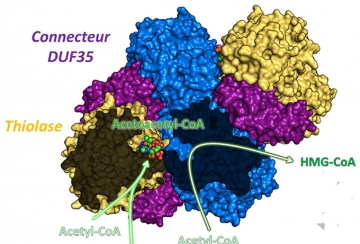Welcome to PROXIMA-2A!
A leading light for biology and micro-crystallography.

PROXIMA 2A (PX2-A) is a microfocus beamline dedicated to biological crystallography and innovative micro-beam methodologies. Opened to the scientific community since 2013, the topics treated on the beamline go beyond standard protein crystallography and include drug discovery, membrane proteins, virus crystallography, small molecule crystallography, powder diffraction and even crystalluria. The beamline is highly automated and designed to help scientists tackle the most challenging structural targets and biological systems. The X-ray energy is rapidly tunable over a wide range (6-18 keV) making the most commonly used absorption edges accessible for anomalous diffraction experiments. The end station is equipped with a high capacity sample-changing system (148 SPINE pins), a high performance micro-diffractometer with a mini-kappa (MD2), an X-ray fluorescence detector (KETEK), and a fast, low-noise, photon-counting, area detector - the EIGER X 9M (238 fps in 9M mode, 750 fps in 4M mode).
See also Biology Health : HelioBio
Team
Last twitter post
Jobs opportunities
Please contact William SHEPARD for more information.
Technical data
6 - 18 keV
~0.0002 (Si 111)
Two U24 canted undulators (4.5 mrad)
White beam – depends on undulator settings
Cryogenically cooled channel cut crystal monochromator, a convex prefocussing mirror and a Kirkpatrick-Baez pair of focussing mirrors
Linear
EIGER X 9M area detector for X-ray diffraction images (238 fps in 9M mode, 750 fps in 4M mode)
Ketek SDD detector for X-ray fluorescence scans
Diamond scCVD and Ti foil XBPMs
High resolution X-ray camera (SOLEIL in-house design)
Scientific opportunities
| Micro-crystallography |
Small and weakly diffracting crystals |
|---|---|
| SAD and MAD phasing |
Phasing with a range of heavy atoms, including sulphur |
| Plate screening |
Screening of crystallization trays |
Before visiting PX2-A
Please contact your LC before departing your lab.
- How many samples?
- Which X-ray wavelengths or heavy atom derivatives?
Sending dewars
Dewars should be sent to your Local Contact (one of the people below):
- William SHEPARD (Beamline Responsable)
- Lidia CICCONE
- Martin SAVKO
SOLEIL's address is:
PROXIMA 2A
Synchrotron SOLEIL
L'Orme des Merisiers
Saint-Aubin, BP 48
91192 GIF-sur-YVETTE CEDEX
FRANCE
Please notify your Local Contact, so that (s)he can refill your dewar upon arrival!
The return of shipping dewars must be the user. Please provide a FEDEX or DHL account number to your Local Contact.
Types of samples (and videos)
PROXIMA-2A will take ANY & ALL samples! This includes the BIG, the SMALL and the UGLY!
- big > 10 microns
- small < 10 microns
- ugly = split, fractured and clumped crystals, because these are sometimes made up of nice micro-crystals!
Types of sample pins :
- SPINE standard pins only
- pin length = 22 mm (from loop to base)
- goniometer horizontal range = -25 to +5 mm
- Manual & robot mounting
- Suitable pins are Hampton, Mitegen & Molecular Dimensions
- BEWARE: the goniometer axis is horzontal and it can not be inclined for easy cryo-transfers
PLEASE PRACTICE BEFORE MOUNTING YOUR FAVORITE CRYSTAL!
- Robotic mounting
A short video explaining mounting procedures :
A further video showing the use of a dry shipper and sample recovery :
During your visit
- Start & finish times for PROXIMA-2A users:
- 8:30 am – 8:00 am
- Equipment & accessories available to users include:
- Microscopes, SPINE pins, loops & wands for fishing crystals
- Cryo-equipment - liquid nitrogen, handling dewars, cryo-tongs, gloves, etc...
- ALL OF THIS EQUIPMENT MUST REMAIN ON THE BEAMLINE!
- Data Collection Control
Users launch their experiments via the MXCuBE GUI
- beam location
- sample transfers (manual & robotic)
- crystal centring
- data collections
- energy changes, Escans & XFE spectra
- Accessible X-ray wavelengths
- 6 – 18 keV
- Accessible absorption edges
- K-edges Fe – Kr
- L3-edges Gd - Rn
- Typical data collection times
- Minimum exposure time 4.2 ms per frame (238 fps), nominal exposure time 25 ms per frame (40 fps)
- 90s per nominal data collection rate (25 ms per frame, 0.1 degrees per frame, 3600 frames)
- most crystals require 25 ms per 0.1 degrees oscillation angle
- Visualising diffraction images
- ADXV
- Data processing
- XDSME
- Canteen Opening Hours
- Closed during shutdowns
- Weekdays (Monday - Friday) : Breakfast 7:30 - 9:00 Lunch 11:45 - 13:45 Dinner 19:00 - 20:30
- Weekends& Holidays : Breakfast 7:30 - 9:00 Lunch 11:45 - 13:45 Dinner 18:00 - 19:30
After your experiment
- Recuperating your data
- download on to external disk drives via USB2 port
- if possible, use the automated script "synchrosync" (Cntrl-C to stop, and then dimount the drive).
- Remove ALL of your samples
- Sign the Safety Approval Sheet
Important: Please send to us any slides, images or publications of your results...
the more the merrier! Bon courage!


